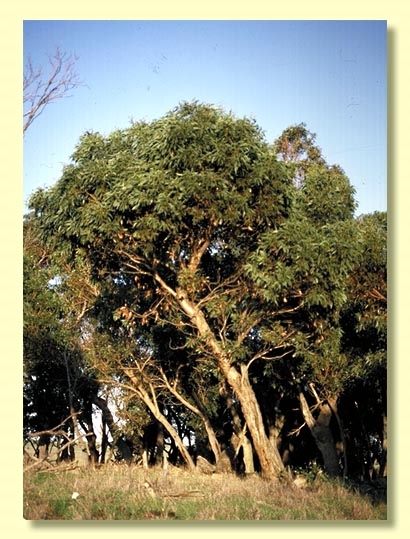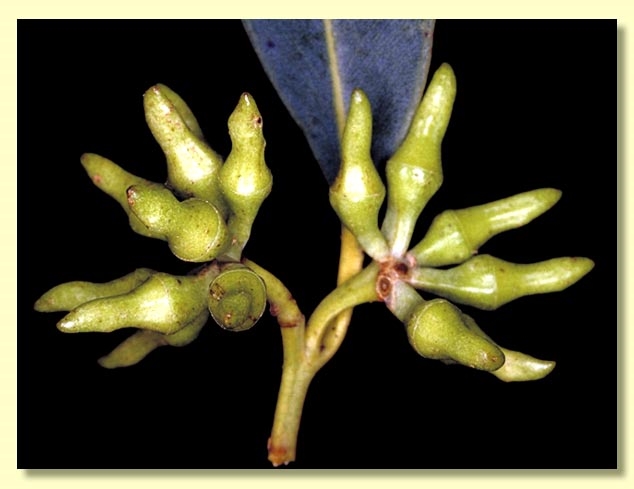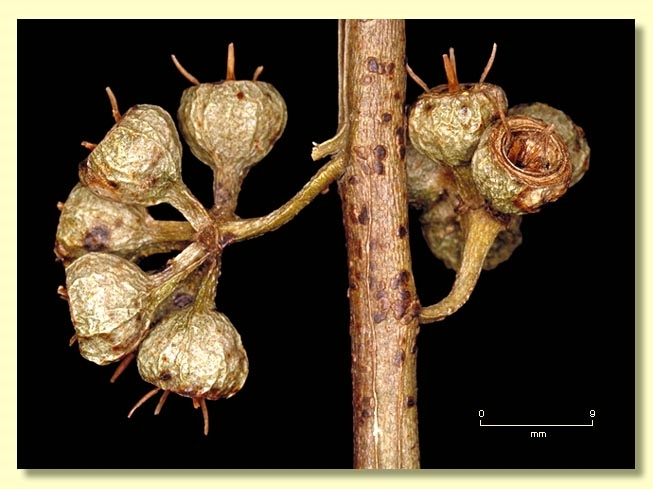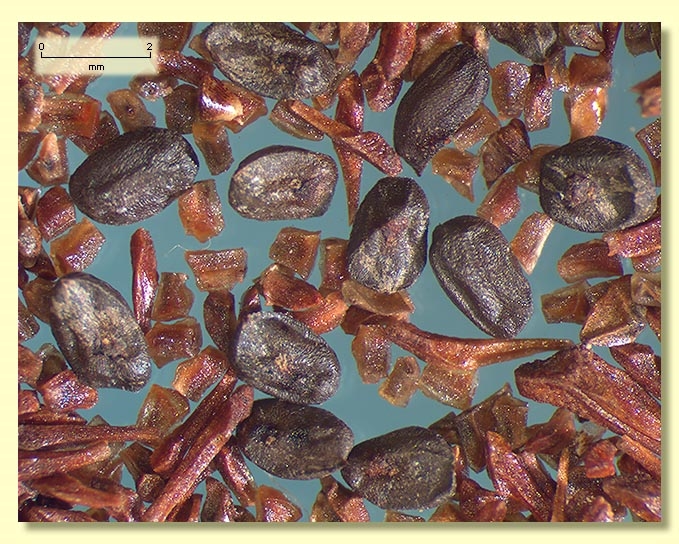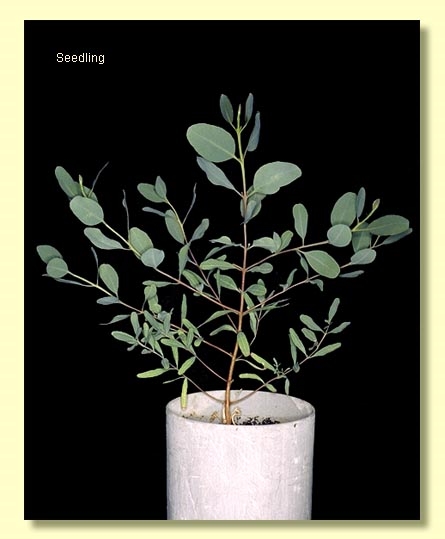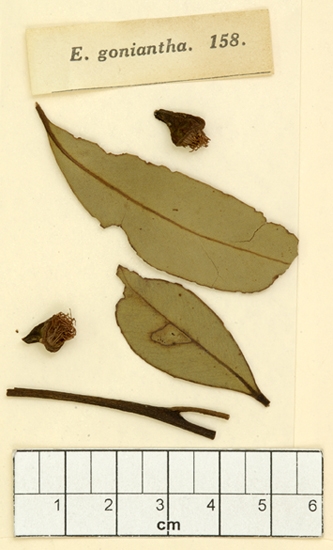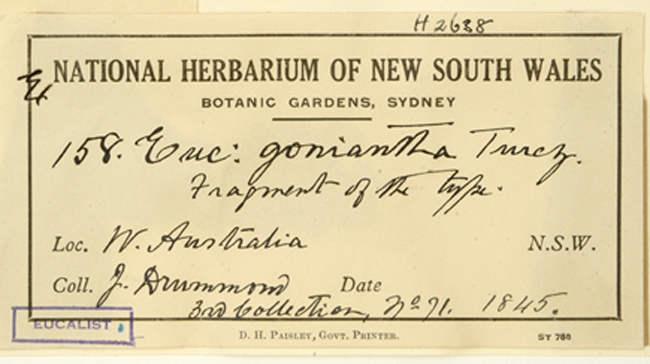Eucalyptus | Symphyomyrtus | Bisectae | Destitutae | Falcatae | Rugatae
Euclid - Online edition
Eucalyptus goniantha subsp. goniantha
Bark on larger stems more or less rough for lower part, thin, fibrous semi-persistent strips, grey to brown, or smooth throughout, pale grey, greeny grey to white over pink-orange.
Branchlets square but not winged, not glaucous; lacking oil glands in the pith.
Juvenile growth (coppice or field seedlings to 50 cm): not seen.
Adult leaves alternate, petioles 1–2.3 cm long; blade lanceolate, 7–13.5 cm long, 1.5–4.5 cm wide, base tapering to petiole, margin entire, apex acute, glossy, green to grey-green, side-veins at an acute or wider angle to midrib, reticulation dense to very dense, intramarginal vein fairly close to margin, oil glands numerous, irregular, intersectional.
Inflorescence axillary unbranched, peduncles spreading to weakly down-turned, angular-flattened, 0.5–2 cm long, buds 7, 9 or 11 per umbel, pedicels angular (pedicels 0.1–1.0 cm long). Mature buds elongated ovoid (1–1.4 cm long, 0.6 cm wide), weakly ribbed on hypanthium at least, creamy white, scar present, operculum contracted to a stout blunt long beak, stamens inflexed, anthers cuboid, versatile, sub-basifixed, dehiscing by longitudinal slits, style long and straight, stigma blunt to slightly rounded, locules 3 or 4, the placentae each with 4 vertical rows of ovules. Flowers creamy white.
Fruit shortly pedicellate (0.1–1.0 cm long), truncate-globose to hemispherical, ribbed or coarsely wrinkled, 0.6–0.7 cm long, 0.8–1.1 cm wide, rim thick, disc usually descending, valves 3 or 4, exserted but fragile.
Seeds grey-brown, 1.5–2.5 mm long, ovoid or flattened-ovoid, dorsal surface very shallowly reticulate, hilum ventral.
Cultivated seedlings (measured at ca node 10): cotyledons Y-shaped (bisected); stems rounded in cross-section; leaves sessile and linear for ca 3 to 10 nodes, then petiolate, alternate at node 11 to > 13, becoming elliptical, sometimes ovate, 2–4 cm long, 0.8–2.5 cm wide, base tapering, apex rounded, dull, green to bluish green.
Flowering has been recorded in January, February, March, June and November.
In the classification of Brooker (2000) Eucalyptus goniantha belongs in Eucalyptus subgenus Symphyomyrtus section Bisectae subsection Destitutae because buds have two opercula, cotyledons are Y-shaped and branchlets lack oil glands in the pith. Within this subsection E. goniantha belongs to a group of ten species and three subspecies characterised by usually pendulous inflorescences with pedicellate ovoid buds with a conical to beaked operculum, truncate-globose fruits with exserted fragile valves and adult leaves that are green, densely reticulate and have numerous intersectional oil glands. The species are the mallets E. falcata, E. ornata, E. purpurata, E. recta, E. rugulata and E. annettae; and the mallees E. dorrienii, E. petrensis, E. ecostata and the newly described E. opimiflora, plus the coastal and sub-coastal mallees E. goniantha (with two subspecies), E. kessellii (with two subspecies), E. notactites and E. semiglobosa. These mallets and mallees together form series Falcatae subseries Rugatae, albeit in a form somewhat modified from Brooker's classification.
E. goniantha is most likely to be confused with E. notactites but the latter frequently has glaucous branchlets that are also winged, and sessile to subsessile buds virtually un-ribbed. E. goniantha and E. kessellii may also be confused. Both species have stout, coarsely but shallowly ribbed buds, never finely ovoid in overall shape as in E. dorrienii, E. ecostata, E. opimiflora or E. petrensis, nor are the umbels of E. goniantha gracefully pendulous. The two subspecies of E. kessellii have broadly diamond-shaped buds in umbels of three or seven on rigidly down-turned flattened peduncles. E. goniantha has erect to spreading umbels of seven to > 11 ovoid buds on flattened to narrowly angular peduncles. The surface of buds of both these species is noticeably cream-coloured at maturity. Larger plants of both E. goniantha and E. kessellii may be small trees with basal rough bark, with that of the latter being harder and darker. Both species have a southern coastal and subcoastal distribution. E. goniantha differs from E. semiglobosa in the buds which are conspicuously short globular and unbeaked in the latter.
Other species in subseries Rugatae, viz. E. falcata, E. purpurata, E. rugulata, E. recta and E. ornata, are all tall mallets from the wheatbelt or nearby, and are easily distinguished from E. goniantha by the finely tapering conical/beaked opercula.
There are two subspecies:
E. goniantha subsp. goniantha
The opercula are elongate and thickly beaked, buds and fruit slightly ribbed . It occurs between Manypeaks and Hassell Beach north-east of Albany on coastal sands.
E. goniantha subsp. kynoura
The buds and fruit are conspicuously corrugate or ribbed with the buds having an operculum with a thick blunt long beak. Only known so far from one bleak headland south-west of Denmark.
[note that E. goniantha subsp. notactites is now regarded as a species, viz. E. notactites .]

